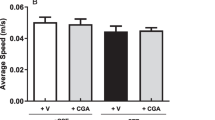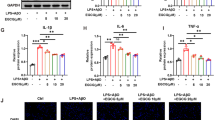Abstract
The oxidative stress-induced dysregulation of the cyclic AMP response element-binding protein- brain-derived neurotrophic factor (CREB-BDNF) cascade has been linked to cognitive impairment in several studies. This study aimed to investigate the effect of minocycline on the levels of oxidative stress markers, CREB, and BDNF in lipopolysaccharide (LPS)-induced cognitive impairment. Fifty adult male Sprague Dawley rats were divided randomly into five groups. Group 1 was an untreated control group. Groups 2, 3, 4 and 5 were treated concurrently with LPS (5 mg/kg, i.p) once on day 5 and normal saline (0.7 ml/rat, i.p) or minocycline (25 and 50 mg/kg, i.p) or memantine (10 mg/kg, i.p) once daily from day 1 until day 14, respectively. From day 15 to day 22 of the experiment, Morris Water Maze (MWM) was used to evaluate learning and reference memory in rats. The levels of protein carbonyl (PCO), malondialdehyde (MDA), catalase (CAT), and superoxide dismutase (SOD) were determined by enzyme-linked immunosorbent assay (ELISA). CREB and BDNF expression and density were measured by immunohistochemistry and western blot analysis, respectively. LPS administration significantly increased escape latency to the hidden platform with decreased travelled distance, swimming speed, target crossings and time spent in the target quadrant. Besides, the hippocampal tissue of LPS rats showed increased levels of PCO and MDA, decreased levels of CAT and SOD, and reduced expression and density of BDNF and CREB. Treatment with minocycline reversed these effects in a dose-dependent manner, comparable to the effects of memantine. Both doses of minocycline treatment protect against LPS-induced cognitive impairment by reducing oxidative stress and upregulating the CREB-BDNF signalling pathway in the rat hippocampus.






Similar content being viewed by others
Data Availability
Enquiries about data availability should be directed to the authors.
References
Cásedas G, Bennett AC, González-Burgos E, Gómez-Serranillos MP, López V, Smith C (2019) Polyphenol-associated oxidative stress and inflammation in a model of LPS-induced inflammation in glial cells: do we know enough for responsible compounding? Inflammopharmacology 27(1):189–197. https://doi.org/10.1007/s10787-018-0549-y
Banks WA, Gray AM, Erickson MA, Salameh TS, Damodarasamy M, Sheibani N et al (2015) Lipopolysaccharide-induced blood-brain barrier disruption: roles of cyclooxygenase, oxidative stress, neuroinflammation, and elements of the neurovascular unit. J Neuroinflammation 12(1):1–15. https://doi.org/10.1186/s12974-015-0434-1
Zhao J, Bi W, **ao S, Lan X, Cheng X, Zhang J et al (2019) Neuroinflammation induced by lipopolysaccharide causes cognitive impairment in mice. Sci Rep 9(1):1–12. https://doi.org/10.1038/s41598-019-42286-8
Thingore C, Kshirsagar V, Juvekar A (2021) Amelioration of oxidative stress and neuroinflammation in lipopolysaccharide-induced memory impairment using Rosmarinic acid in mice. Metab Brain Dis 36(2):299–313
Guo T, Zhang D, Zeng Y, Huang TY, Xu H, Zhao Y (2020) Molecular and cellular mechanisms underlying the pathogenesis of Alzheimer’s disease. Mol Neurodegener 15(1):1–37
Bitner RS (2012) Cyclic AMP response element-binding protein (CREB) phosphorylation: a mechanistic marker in the development of memory enhancing Alzheimer’s disease therapeutics. Biochem Pharmacol 83(6):705–714. https://doi.org/10.1016/j.bcp.2011.11.009
Nam SM, Choi JH, Yoo DY, Kim W, Jung HY, Kim JW et al (2014) Effects of curcumin (Curcuma longa) on learning and spatial memory as well as cell proliferation and neuroblast differentiation in adult and aged mice by upregulating brain-derived neurotrophic factor and CREB signaling. J Med Food 17(6):641–649
Wang B, Zhao J, Yu M, Meng X, Cui X, Zhao Y et al (2014) Disturbance of intracellular calcium homeostasis and CaMKII/CREB signaling is associated with learning and memory impairments induced by chronic aluminum exposure. Neurotox Res 26(1):52–63
Xu Y, Zhang C, Wu F, Xu X, Wang G, Lin M et al (2016) Piperine potentiates the effects of trans-resveratrol on stress-induced depressive-like behavior: involvement of monoaminergic system and cAMP-dependent pathway. Metab Brain Dis 31(4):837–848. https://doi.org/10.1007/s11011-016-9809-y
Yamashita K, Wiessner C, Lindholm D, Thoenen H, Hossmann KA (1997) Post-occlusion treatment with BDNF reduces infarct size in a model of permanent occlusion of the middle cerebral artery in rat. Metab Brain Dis 12(4):271–280. https://doi.org/10.1007/BF02674671
Motaghinejad M, Farokhi N, Motevalian M, Safari S (2020) Molecular, histological and behavioral evidences for neuroprotective effects of minocycline against nicotine-induced neurodegeneration and cognition impairment: Possible role of CREB-BDNF signaling pathway. Behav Brain Res 386:112597. https://doi.org/10.1016/j.bbr.2020.112597
Motaghinejad M, Mashayekh R, Motevalian M, Safari S (2021) The possible role of CREB-BDNF signaling pathway in neuroprotective effects of minocycline against alcohol-induced neurodegeneration: molecular and behavioral evidences. Fundam Clin Pharmacol 35(1):113–130
Romero-Miguel D, Lamanna-Rama N, Casquero-Veiga M, Gómez-Rangel V, Desco M, Soto-Montenegro ML (2021) Minocycline in neurodegenerative and psychiatric diseases: an update. Eur J Neurol 28(3):1056–1081
Plane JM et al (2021) Prospects for minocycline neuroprotection. Arch Neurol 67(12):1442–1448
Beheshti Nasr SM, Moghimi A, Mohammad-Zadeh M, Shamsizadeh A, Noorbakhsh SM (2013) The effect of minocycline on seizures induced by amygdala kindling in rats. Seizure. 22(8):670–674. https://doi.org/10.1016/j.seizure.2013.05.005
Hemmati F, Dargahi L, Nasoohi S, Omidbakhsh R (2013) Neurorestorative effect of FTY720 in a rat model of Alzheimer’s. Behav Brain Res 252:415–421
Subhramanyam CS, Wang C, Hu Q, Dheen ST (2019) Microglia-mediated neuroinflammation in neurodegenerative diseases. Semin Cell Dev Biol 94(May):112–120
Zakaria R, Wan Yaacob WMH, Othman Z, Long I, Ahmad AH, Al-Rahbi B (2017) Lipopolysaccharide-induced memory impairment in rats: a model of Alzheimer’s disease. Physiol Res 66(4):553
Ciesielska A, Matyjek M, Kwiatkowska K (2021) TLR4 and CD14 trafficking and its influence on LPS-induced pro-inflammatory signaling. Cell Mol Life Sci 78(4):1233–1261. https://doi.org/10.1007/s00018-020-03656-y
Ali AM, Kunugi H (2021) The effects of royal jelly acid, 10-hydroxy-trans-2-decenoic acid, on neuroinflammation and oxidative stress in astrocytes stimulated with lipopolysaccharide and hydrogen peroxide. Immuno 1(3):212–222
Yaseen E, Qaid A, Long I, Azman KF, Ahmad AH, Othman Z et al (2021) Quantitative description of publications (1986–2020) related to Alzheimer disease and oxidative stress: a bibliometric study. J Biomed Boitechnol 12(1):955–968
Yaacob WMHW, Long I, Zakaria R, Othman Z (2018) Tualang honey and its methanolic fraction improve LPS-induced learning and memory impairment in male rats: comparison with memantine. Curr Nutr Food Sci 16(3):333–342
Amraie E, Pouraboli I, Rajaei Z (2020) Neuroprotective effects of Levisticum officinale on LPS-induced spatial learning and memory impairments through neurotrophic, anti-inflammatory, and antioxidant properties. Food Funct 11(7):6608–6621. https://doi.org/10.1039/d0fo01030h
Noworyta-Sokolowska K, Górska A, Golembiowska K (2013) LPS-induced oxidative stress and inflammatory reaction in the rat striatum. Pharmacol Reports 65(4):863–869
Sharma N, Nehru B (2015) Characterization of the lipopolysaccharide induced model of Parkinson’s disease: role of oxidative stress and neuroinflammation. Neurochem Int 87:92–105. https://doi.org/10.1016/j.neuint.2015.06.004
Wan Yaacob WMH, Long I, Zakaria R, Othman Z (2021) Tualang honey and its methanolic fraction ameliorate lipopolysaccharide-induced oxidative stress, amyloid deposition and neuronal loss of the rat hippocampus. Adv Tradit Med. 21(1):121–129. https://doi.org/10.1007/s13596-020-00449-3
Hou Y, **e G, Liu X, Li G, Jia C, Xu J et al (2016) Minocycline protects against lipopolysaccharide-induced cognitive impairment in mice. Psychopharmacology 233(5):905–916. https://doi.org/10.1007/s00213-015-4169-6
Fan LW, Pang Y, Lin S, Tien LT, Ma T, Rhodes PG et al (2005) Minocycline reduces lipopolysaccharide-induced neurological dysfunction and brain injury in the neonatal rat. J Neurosci Res 82(1):71–82
Stolp HB, Ek CJ, Johansson PA, Dziegielewska KM, Potter AM, Habgood MD et al (2007) Effect of minocycline on inflammation-induced damage to the blood–brain barrier and white matter during development. Eur J Neurosci 26(12):3465–3474. https://doi.org/10.1111/j.1460-9568.2007.05973.x
Keilhoff G, Schild L, Fansa H (2008) Minocycline protects Schwann cells from ischemia-like injury and promotes axonal outgrowth in bioartificial nerve grafts lacking Wallerian degeneration. Exp Neurol 212(1):189–200
Cankaya S, Cankaya B, Kilic U, Kilic E, Yulug B (2019) The therapeutic role of minocycline in Parkinson’s disease. Drugs Context 8:1–14
Morren JA, Galvez-Jimenez N (2012) Current and prospective disease-modifying therapies for amyotrophic lateral sclerosis. Expert Opin Investig Drugs 21(3):297–320
Funding
The research funding for this work came from Universiti Sains Malaysia (RUI 1001/PPSK/8012269).
Author information
Authors and Affiliations
Corresponding author
Ethics declarations
Conflict of interest
The authors declared that there were no possible conflicts of interest in the research, writing, or publishing of this paper.
Additional information
Publisher's Note
Springer Nature remains neutral with regard to jurisdictional claims in published maps and institutional affiliations.
Rights and permissions
Springer Nature or its licensor (e.g. a society or other partner) holds exclusive rights to this article under a publishing agreement with the author(s) or other rightsholder(s); author self-archiving of the accepted manuscript version of this article is solely governed by the terms of such publishing agreement and applicable law.
About this article
Cite this article
Qaid, E.Y.A., Abdullah, Z., Zakaria, R. et al. Minocycline Protects Against Lipopolysaccharide-Induced Cognitive Impairment and Oxidative Stress: Possible Role of the CREB-BDNF Signaling Pathway. Neurochem Res 48, 1480–1490 (2023). https://doi.org/10.1007/s11064-022-03842-3
Received:
Revised:
Accepted:
Published:
Issue Date:
DOI: https://doi.org/10.1007/s11064-022-03842-3




